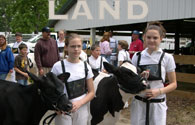Livestock
What's the difference between brown cows and black-and-white cows? What is a broiler? How much milk does one cow produce?
Dairy farms and poultry farms are among the region's top five agricultural industries. Over the years, dusty barnyards and drafty
barns have given way to climate-controlled chicken houses and automated milking machines.
Livestock convert grass and grain, which we can not easily digest, into protein that we can. Fed a nutritious diet, a cow for
example, can produce about 100 glasses of millk in her lifetime.
Caring for Animals

The care of farm animals is a tradition - and ethic - ingrained from an early age. At county fairs and 4-H events, kids and youth
showcase the animals under their care.
In learning to be humane guardians of their animals, young farmers also learn an economic lesson: Only healthy animals produce
healthy, high quality meat, milk and eggs.
Little Kentucky
Maryland has been a top horse breeding state since colonial times. Cecil County - sometimes referred to as Little Kentucky - is
home to both large and small horse breeding farms. Some also train racehorses. Horse stables that proide boarding, riding and lessons
are found throughout Chesapeake Country.



